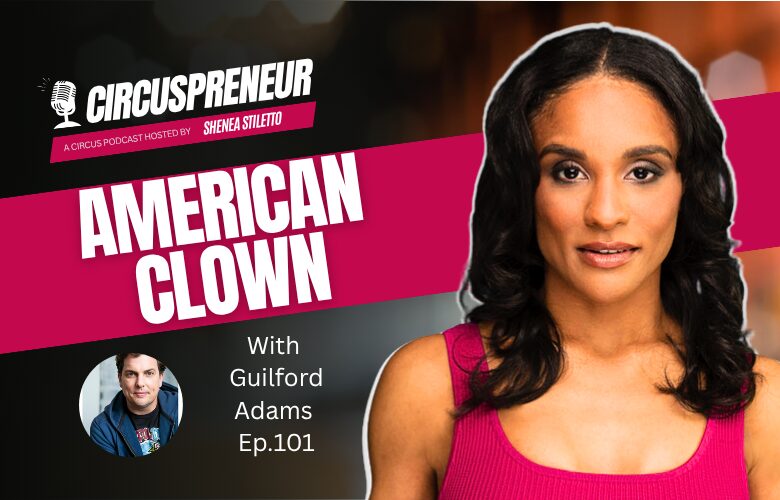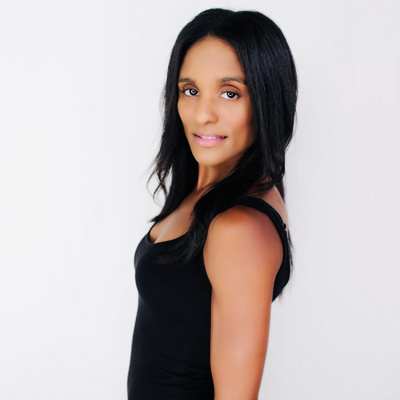Guilford Adams: American Clown Movie

On this episode of the Circuspreneur Podcast, host Shenea Stiletto interviews, writer, director, and Clown documentarian Guilford Adams.
American Clown is a feature-length documentary exploring the plight of clowns in a country that looks on them with a growing sense of apprehension and disdain. Guest appearances include John C. Reilly, Steve-O, David Arquette, and Matt Morgan.
Guilford Adams has worked as a professional clown for nearly two decades. In recent years, he’s watched media reports of “clowns” terrorizing neighborhood streets at night, the reboot of “IT” and Pennywise, the shuttering of Ringling Bros. and Barnum & Bailey Circus and the unceremonious end to the regional Ronald McDonald program, where “assistants” to Ronald appeared at grand openings, community events and elementary school shows. Guilford was one of those dismissed assistants to Ronald. As he felt the culture shifting, he started thinking about what it might mean for him, his family and all of his clowning comrades. The film follows Guilford’s quest as he surveys the current state of clowning with his friends who are also struggling to adapt, as well as legendary performers of past eras and their take on the history and art of clowning.
American Clown premiered at the Chinese theater at the Los Angeles Dances with Films Festival.
Guilford Adams was moved to make American Clown as a response to the cultural shift that has increasingly portrayed clowns in a negative, often frightening light. With nearly 30 years in the clowning profession, Adams witnessed firsthand the decline in public perception, the shuttering of institutions like Ringling Brothers, and the dismissal of educational clown programs like the Ronald McDonald assistant initiative in which he worked.
In 2016, when media headlines sensationalized stories of “scary clowns” lurking in neighborhoods, Adams became frustrated by how the term “clown” was being used. “News outlets were calling me to comment on how horror clowns were taking our jobs,” he said. “But they didn’t want to pay me, and they wanted me to come in costume to cry about it.”
Rather than play along, he began working on a documentary to correct the record. American Clown explores the humanity behind the greasepaint and highlights the diverse and dignified reality of working clowns across the U.S. “The horror clown will always be there,” he says, “but we deserve a seat at the table too.”
How did Guilford’s personal clowning journey shape the film?
Guilford’s path into clowning wasn’t linear. He began with balloon animals and magic tricks as a child, then detoured into competitive diving before rediscovering clowning through acting in college. His physicality became a gateway: “I couldn’t compete with musical theater kids, but I could tumble and pratfall.”
After moving to L.A., Guilford started performing at kids’ parties, which led to founding Los Angeles Clown Company in 2003. He even worked for a decade as an assistant to Ronald McDonald, one of the few clowning jobs that offered benefits. But by 2017, that role vanished—as did many other stable clowning jobs.
His career, built on over 4,000 parties, commercials, and live performances, gave him an insider’s view of the profession’s joys and precarities. That perspective grounds American Clown in lived experience. “It was always on-the-job training for me,” he shares, “and this film is part of that continuing education for everyone else.”
What does American Clown reveal about the larger challenges facing the clowning and circus industries?
Adams sees the clowning profession as a microcosm of broader issues in the performing arts: lack of benefits, dwindling institutional support, and misrepresentation in media. With the collapse of major circuses, many performers—especially clowns—found themselves adrift in a gig economy that offers little security.
He points out how few pathways exist for young people to pursue clowning professionally. “There’s no clown degree pipeline. And outside of Cirque du Soleil, which still offers benefits, most of us are on our own.”
Compounding this is the horror genre’s co-opting of the clown image. “Kids today only see scary clowns,” Guilford laments. “If all they see is Pennywise, they never get exposed to joyful or comedic clowning. That’s a dangerous cultural blind spot.”
He calls for “positive clowning representation” to balance the narrative. “David Arquette is doing this with Bozo. Some purists may not love it, but it gets people thinking differently. That’s a start.”
How does American Clown address advocacy, labor rights, and cultural perception?
A strong undercurrent in the documentary is arts labor advocacy. Guilford, like host Shanae Stiletto, emphasizes that circus and clowning professionals are workers, not whimsical hobbyists. “People say, ‘Is this your real job?’ And I’m like—yes, for 20 years,” Guilford explains. “We have families. We pay bills. We deserve respect.”
He notes the irony in how media uses “clown” as an insult—yet never calls someone “a man impersonating a clown” like they would “a man impersonating a cop.”
The film is a call to reclaim that language. “Words matter,” Guilford insists. “Clown shouldn’t mean ‘fool’ any more than ‘cop’ should mean ‘fake.’ We’ve been too quiet while our word’s been weaponized. This documentary is my way of pushing back.”
He applauds efforts to raise circus visibility in policymaking circles—like recent industry visits to D.C. to push for more accurate and respectful language. “We’re an industry. We deserve protections, platforms, and acknowledgment.”
What does Guilford hope audiences take away from American Clown?
Ultimately, American Clown is about visibility, dignity, and optimism. “I just wanted to put my clown shoe forward,” Guilford says, “and keep the conversation going.”
While acknowledging the dark sides—media misrepresentation, lack of financial security, and cultural erasure—he believes clowning is still fertile ground for innovation. “Clowns are adaptable. Where others see challenges, we see opportunities.”
His endgame? Not to erase horror clowns, but to balance the field with joyful, authentic depictions. “We’re not trying to replace scary clowns—we just want to exist too.”
Featuring interviews with Steve-O, David Arquette, and a cross-section of modern and legacy clowns, American Clown invites viewers to see the art form anew. “If sharks can get better PR than clowns,” Guilford jokes, “then we’ve got work to do.”
Key Takeaways
Clowning is a serious profession, not just a hobby or gag—clowns are skilled artists with real careers, responsibilities, and families.
The documentary American Clown aims to reclaim the narrative, offering a heartfelt, authentic look at clowning beyond the horror stereotypes.
The industry has been hit hard, with the closure of Ringling Brothers, Big Apple Circus, and corporate clown programs, leaving fewer career paths and job security.
Language matters—using “clown” as an insult contributes to public misunderstanding and devalues the profession. Clowns deserve the same respect as other performing artists.
The solution is positive visibility—by showing diverse, joyful, and meaningful clowning, the community can push back against negative portrayals and build a stronger future.
Listen to this Episode on:
Editor's Note: At StageLync, an international platform for the performing arts, we celebrate the diversity of our writers' backgrounds. We recognize and support their choice to use either American or British English in their articles, respecting their individual preferences and origins. This policy allows us to embrace a wide range of linguistic expressions, enriching our content and reflecting the global nature of our community.
🎧 Join us on the StageLync Podcast for inspiring stories from the world of performing arts! Tune in to hear from the creative minds who bring magic to life, both onstage and behind the scenes. 🎙️ 👉 Listen now!
